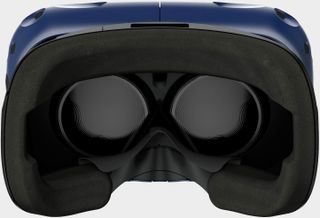Valve is updating SteamVR to run VR games more smoothly on lower end GPUs
Motion Smoothing will fill in the gap when there are dropped frames.

Valve is hoping to enable "more players on more PCs to play high-fidelity VR games" by adding a featured called Motion Smoothing to SteamVR. It's similar to a technique that is commonly found on TVs, except Valve claims it's tackled the issue of latency.
"If you have a flatscreen TV, you may be familiar with the term Motion Smoothing. TVs apply Motion Smoothing by interpolating between two existing frames to create a new in-between frame. This smooths out the frames and increases framerate, but it also adds latency—providing passable results for TV but definitely not the right way to go in VR," Valve explains.
SteamVR's implementation is a little different. When SteamVR detects that a game or application is going to drop frames. Motion Smoothing jumps in and does its thing. More specifically, it examines the last two frames that were delivered successfully, estimates motion and animation, and then extrapolates a new frame.
By synthesizing new frames in this manner, Valve claims it is able to maintain a game or application's full framerate and advance motion forward, all the while avoiding judder.
"This means that the player is still experiencing full framerate (90Hz for the Vive and Vive Pro), but the application only needs to render 1 out of every 2 frames, dramatically lowering the performance requirements. Even better, if synthesizing a new frame for every frame delivered by the application still leads to performance issues, Motion Smoothing is designed to scale further down to synthesize 2 frames or even 3 frames for every 1 frame delivered," Valve says.
To be clear, this isn't something entirely new in the VR space. Oculus employs a similar technique called Asynchronous Spacewarp (ASW) on the Rift, or otherwise known as Asynchronous Reprojection. In the absence of these algorithmic tricks, VR headsets can get temporarily stuck on a frame. That's what results in judder.
"Not only can lower-end GPUs now produce smooth frames in applications that were previously too expensive, higher-end GPUs can now render at an even higher resolution increasing the fidelity of all experiences on all VR systems," Valve says.
The biggest gaming news, reviews and hardware deals
Keep up to date with the most important stories and the best deals, as picked by the PC Gamer team.
Motion Smoothing only kicks on when needed, and then turns itself off right after. However, if users find that it's causing visual anomalies or other problems, they can disable it.
For now, Motion Smoothing is in beta and only works in Windows 10 system running Nvidia hardware. It's not clear when Valve will expand testing to include AMD GPUs as well.
Paul has been playing PC games and raking his knuckles on computer hardware since the Commodore 64. He does not have any tattoos, but thinks it would be cool to get one that reads LOAD"*",8,1. In his off time, he rides motorcycles and wrestles alligators (only one of those is true).
Most Popular






